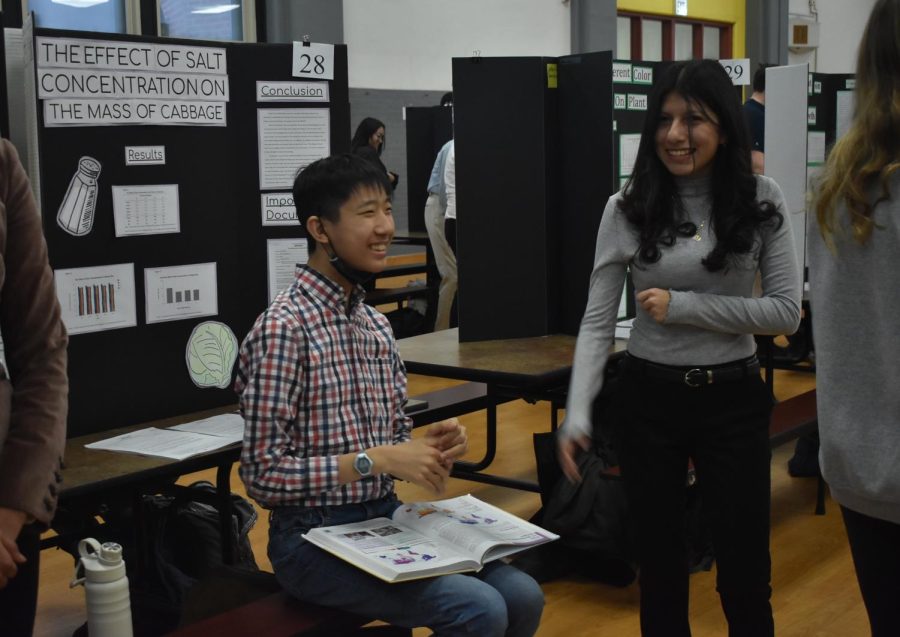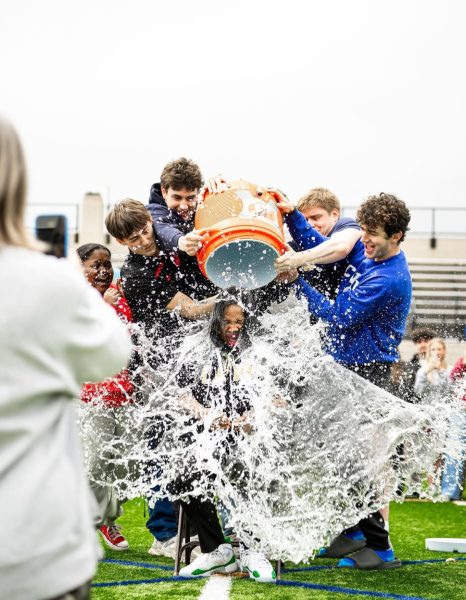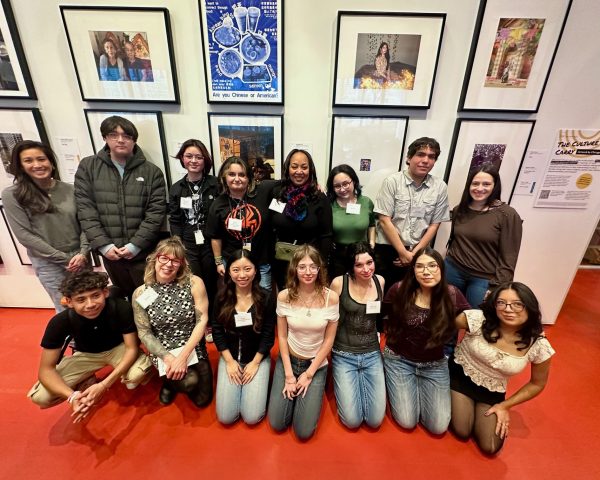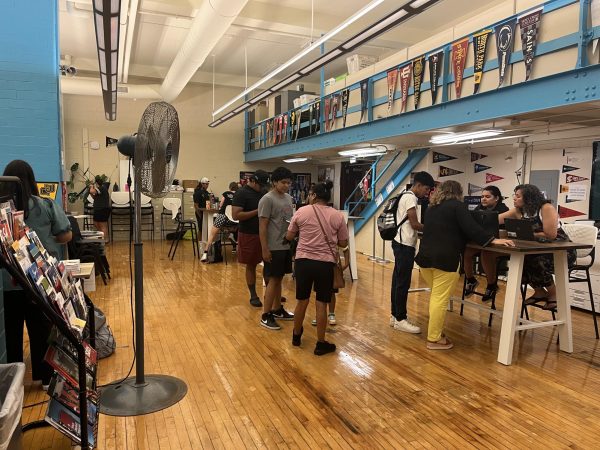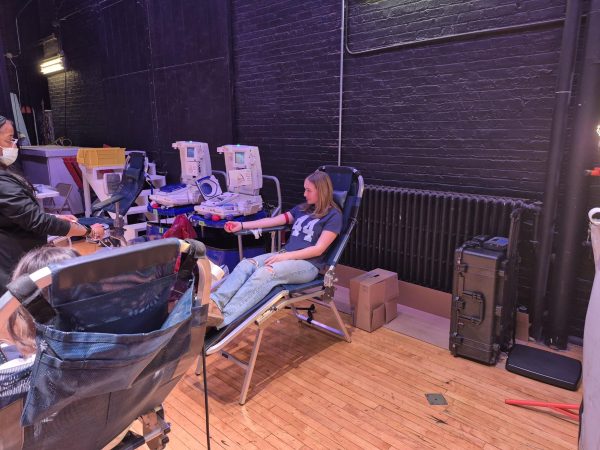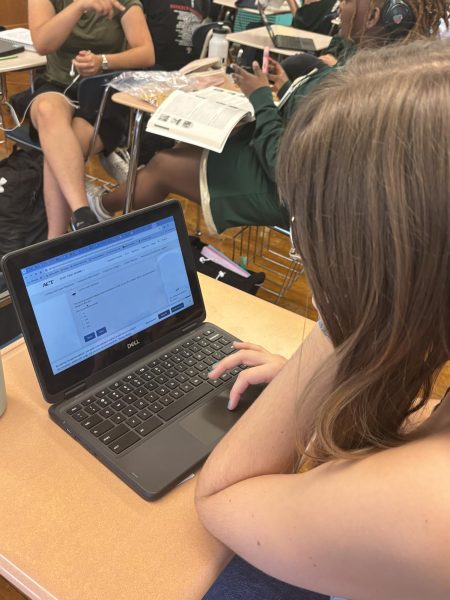Alpha Science Fair showcases STEM innovation at Lane
Three students reading a science fair project’s poster board in the cafeteria.
Poster boards, jittery students and judges line the cafeteria tables; the conversations begin to morph with discussions ranging from behaviorism to horticulture to biochemistry. Suddenly, Bianca Verdin’s Energy-efficient Walking Robot starts walking across the floor, causing everyone to turn their heads, and the room erupts in applause.
The annual Alpha STEM Exhibition was on Dec. 8, where Lane’s Alpha students presented the research projects that they have been conducting over the last several months to address a real-world problem. There are a variety of categories students are able to choose from, including but not limited to, health science, microbiology, chemistry and behavioral science.
This year the top 10 projects from the Alpha Science Fair were from Alexander Czempinski, Griffin Stofko, Sophia Veranga, Itzaith Aguero, Alaina Valmassei, Bridget Berg, Yumou Lu, Bianca Verdin, Sydney Curran and Landra Ream. They will all be advancing to the regional competition where they will represent Lane and potentially move on to city, state and even international competitions.
Nathan Nordlund, the Alpha Honors English II and AP English Literature and Composition teacher, described the intense process the students undergo in preparation for the December fair.
“They collect data after they’ve done extensive background research on what scientists in their field have basically established as the leading edge of how these problems are addressed using that scientific discipline,” Nordlund said. “So they go through quite a process and they create a paper, just like a scientist would publish in a scholarly journal.”
Many of the participants are sophomores who have been preparing for the exhibition since the beginning of their freshman year. As freshmen, they also had the opportunity to participate in the May fair where they were able to receive feedback from professionals in their field in order to finalize and perfect their projects for December.
“Those are strictly freshmen in that cohort that presented in the May fair [which] is a self-contained fair just at Lane Tech, and they are learning the process of researching. They’re learning the process of scientific investigation and how to report on that and draw conclusions from that,” Nordlund said.
Sophomore Sophia Veranga studied the effect of tone on placebo and spent the summer researching and preparing her project for the fair.
“I did a subliminal messaging trial, where I gave different groups of people different sorts of expectancy by giving them a presentation in different tones and seeing how they responded to what I said,” Veranga said.
Veranga explained how she measured the placebo effect in her research by receiving human responses through a Google Form. Through the survey questions, Veranga was able to gather how the participants received her message based on the tone of her voice in the presentations.
“I basically asked them one of two questions. One is do you believe you were given a subliminal message? And so that’s measuring how much they believed me because [of] my tone. Then the next one is, did you see any odd occurrences within the [presentation] that proves you saw that subliminal message? And that’s them experiencing a placebo effect where they think something is there when it’s actually not,” Veranga said.
According to Lucy Young, the Alpha STEM Department Chair, STEM Fair Coordinator and Alpha Honors Chemistry teacher, participating students also have the opportunity to do continuations of their projects from previous years.
“Students in the December fair have the chance to expand on their project from the previous May 2022 fair,” Young said. “What that means is when you do any research, it’s a continuation from year to year. Some students do that from freshman year, sophomore year, junior year [and] senior year.”
While most of the science fair participants are sophomores, this year, two Alpha seniors, Sydney Curran and Julian Olszewski, have been developing their projects since their freshman year.
Curran engineered an RFID Smart Toy for young children and has been studying the science behind human-computer interaction and child-computer interaction.
“I am designing a kid’s toy,” Curran said. “It uses RFID — which is radio frequency identification, the technology in contact with credit cards [and] Ventra cards — to communicate with different types of pieces.
“When different pieces like a triangle, or a three- or part of a two-piece puzzle gets placed on top of the device, the device will light up in a way that corresponds to those pieces and helps keep the kids more engaged with the analog toys, similar to the way they would play with an iPad,” Curran continued.
Since Curran has been expanding on her science fair project since freshman year, the interruption of the pandemic created a major obstacle in the testing phases of her design.
“With COVID, I remember in tenth grade, it was figuring out how I could design a product for humans without actually being able to test it for humans because no one was doing anything because of the pandemic,” Curran said.
Olszewski, on the other hand, has been researching the effects of PFAS on P. lunula, an algae genus. PFAS is a man-made chemical that migrates through the soil, water and air. Because it does not break down, it remains persistent in the environment. In fact, traces of PFAS can be found in the blood of humans and animals.
“What I’m doing is I’m testing the effect of its toxicity on this one species of algae that’s bioluminescent, using bioluminescence emitted as a measure of metabolic stress; indicating that higher decreases in [the] bioluminescent output result in higher toxicity of the compound,” Olszewski said.
As a senior, Olszewski also recognized the difficulty of balancing his science fair project and the challenges that come with senior year.
“I would definitely say that, despite having a head start in my research, it was very hard to organize myself,” Olszewski said. “Given that there’s just so [many] demands during senior year with college apps and everything. I did manage to pull through and I’m really glad I did.”
The students are evaluated by judges, some of whom are professionals in the STEM field. Dan Ortiz is a Lane Tech alumnus and is currently working as a software engineer. He described the main criteria he used to evaluate the Alpha students’ projects.
“I think one of the main things is you want to make sure that the procedures are being followed correctly and that you really have some good controls in place to make sure that your data is coming out pretty valid,” Ortiz said.
The unique aspect of the Alpha program and the Alpha science fair is the amount of support these students receive from their Alpha teachers and mentors. Throughout the entire process, the participants are provided with guidance from professionals so that they can further explore the scientific topics that they are passionate about.
“Our Lane Tech Alpha STEM program is different than any other school that I’ve talked to in which we have support from not just the science teacher, but the English teacher, the math teacher, and then there’s also a sponsor who’s one of our STEM professionals in the building,” Young said. “So that’s what I love about this program — because of that, the students [are] very well supported.”
Your donations directly fund the Lane Tech student journalism program—covering essential costs like website hosting and technology not supported by our school or district. Your generosity empowers our student reporters to investigate, write, and publish impactful stories that matter to our school community.
This website is more than a publishing platform—it's an archive, a research tool, and a source of truth. Every dollar helps us preserve and grow this resource so future students can learn from and build on the work being done today.
Thank you for supporting the next generation of journalists at Lane Tech College Prep!
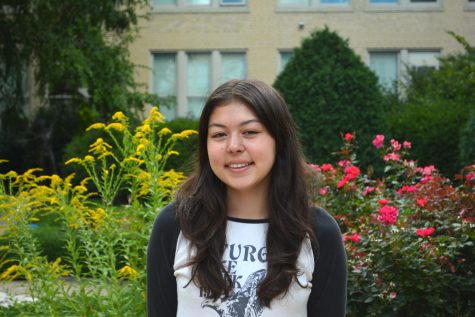
Nina is a senior and this is her second year writing for The Champion where she covers A&E reviews and features. She is part of the Omega Program,...
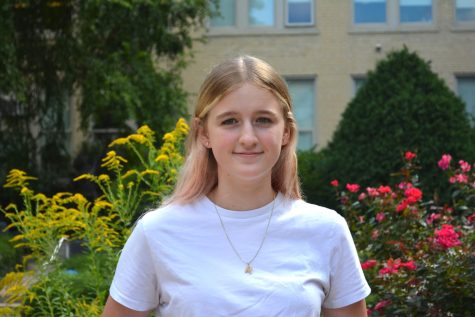
Ruby Thompson is a senior in her second year with The Champion. She can often be seen taking photos on the sidelines during Lane sports games, and she...


